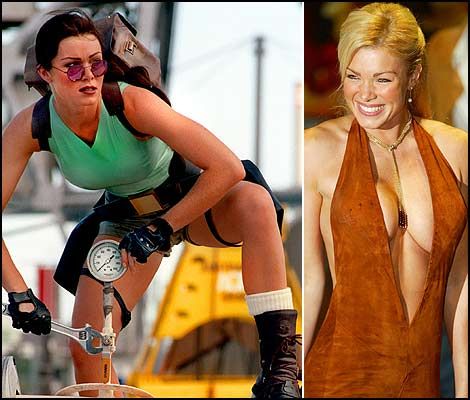|
Lara Croft


Featured
Websites
Captain
Cooks Casino - play Tomb Raider slot online
Tomb
Raider Tomb
Raider Movie

Tomb Raider - Secret Of The Sword video slot game


Lara
Croft is a fictional character and the protagonist
of Eidos Interactive's Tomb Raider video game
series. Designed by Toby Gard, she has also been
featured in movies (in which she was portrayed
by Angelina Jolie), comic books, novels, and a
series of animated short films. In 2006, Lara
was honoured with a star on the Walk of Game,
and was awarded a Guinness World Record recognizing
her as the "most successful human video game
heroine."
Lara
is generally presented as a beautiful, intelligent,
athletic, and somewhat reckless Englishwoman of
noble birth who travels the world in pursuit of
priceless artifacts. Known as both an archaeologist
and an adventurer, she frequently ventures into
ancient, and often very hazardous, tombs and ruins.
In addition to traps and puzzles, Lara encounters
a variety of enemies including rivals, gangsters,
dangerous animals (including dinosaurs), legendary
creatures, and supernatural beings. The fantastic
nature of her archaeology related adventures have
drawn comparisons to Indiana Jones.
Character
creation
Initially,
designer Toby Gard focused on creating the settings
for Tomb Raider and the main character was essentially
an Indiana Jones clone. When this character was
deemed unacceptable, Gard placed his attention
on designing a new one. One factor that influenced
Gard to use a female character was that he noticed
his male co-workers often preferred using female
characters in Virtual Fighter. The redesigned
character was initially a South American woman
named Laura Cruz. She eventually evolved into
an English woman named Lara Croft. Her name was
picked from a phone book for sounding "UK
friendly."
Actor
portrayal
Video games
Lara
has been voiced by five actresses throughout the
video game series:
* Shelley Blond in Tomb Raider
* Judith Gibbins in Tomb Raider II and Tomb Raider
III
* Jonell Elliott in Tomb Raider: The Last Revelation,
Tomb Raider Chronicles, and Tomb Raider: The Angel
of Darkness
* Keeley Hawes in Tomb Raider: Legend, Tomb Raider:
Anniversary, Tomb Raider: Underworld
* Charlotte Asprey voiced young Lara in the flashback
sequences of Tomb Raider: Legend
In
the upcoming Tomb Raider: Underworld, Olympic
gymnast and stunt woman Heidi Moneymaker is providing
motion capture for Lara's movements.
Film and animation
Lara
was brought to life by actress Angelina Jolie
for the movies Tomb Raider (2001) and Tomb Raider:
The Cradle of Life (2003). Rachel Appleton portrayed
young Lara in the first film.
In
the 2007 Re\Visioned: Tomb Raider Animated Series,
Lara was voiced by Minnie Driver.
Models
Lara
has also been portrayed by the following models
for public appearances and promotions:
* Katie Price (Jordan): 'portrayed' Lara Croft
at ECTS before official models were cast
* Nathalie Cook: 1996-1997 (mostly unknown before
Tomb Raider became famous)
* Rhona Mitra: 1997-1998
* Vanessa Demouy: 1997 (hired by a French video
game magazine for a photoshoot)
* Nell McAndrew: 1998-1999
* Lara Weller: 1999-2000
* Ellen Rocche: 2000 (hired by Brazilian distributor
of Eidos' games to promote The Lost Artifact)
* Lucy Clarkson: 2000-2002
* Jill de Jong: 2002-2004
* Karima Adebibe: 2006-2008
* Alison Carroll: 2008 to present
Nell
McAndrew was immediately axed from her stint as
Lara in 1999 after posing nude in an issue of
Playboy. This was partly due to the fact Playboy
printed references to Lara Croft and Tomb Raider
on the cover (which were quickly removed when
Eidos threatened with a lawsuit).
From
February 2006, the model role was played by a
previously unknown sales assistant from London,
Karima Adebibe, then aged 20. She retired in 2008.
Many
of the models were united by FHM in May 2007 to
celebrate the release of Tomb Raider: Anniversary.
On
11 August 2008, Alison Carroll was revealed as
the new promotional face of Lara Croft.
Characteristics
Continuities
There
are two different continuities within the Tomb
Raider video games. The first continuity was created
by Core Design, and encompasses the first six
Tomb Raider games. The second and current continuity
was introduced by Crystal Dynamics for the series'
reinvention in Tomb Raider: Legend. Both continuities
were created with the participation of Toby Gard.
Additionally, Lara Croft's film and comic book
appearances present numerous differences from
the game continuities.
Back
story
In
the first continuity, the Tomb Raider game manual
tells of Lara's birth to Lord Henshingly Croft
and how she was raised as an aristocrat surrounded
by wealth and luxury. It also tells how, at the
age of 21, she was the sole survivor of a plane
crash in the Himalayas and was forced to rely
on her wits to stay alive. The incident changed
her, and inspired her to forsake her life of comfort
and security in favour of travelling around the
world alone. This led to her being disowned by
her family.
Tomb
Raider: The Last Revelation expanded Lara's back
story by describing how, at the age of 16, she
accompanied a famous archaeologist named Werner
Von Croy on an expedition to Cambodia. The events
there created a rift between them, but also fostered
Lara's interest in ancient civilizations and artifacts.
According to the memorial statue shown in Tomb
Raider Chronicles Lara was born in 1968, 28 years
before the first game.
The
second continuity presents a different back story.
Several flashback sequences in Legend show how
Lara, at the age of 9, survived a plane crash
in Himalayas which led to the mysterious disappearance
(and presumed death) of her mother, Amelia Croft.
Lara then somehow managed to survive a ten day
journey to Kathmandu where she was able to contact
her father, Richard Croft. Lara spent the remainder
of her childhood under the watchful eye of her
father, an archaeologist who allowed Lara to accompany
him on archaeological expeditions. Legend and
Anniversary both strongly imply most, if not all,
of these expeditions were conducted to discover
what happened to Lara's mother. At the age of
18, when her father died under unknown circumstances,
Lara inherited the Croft estates along with the
title "Countess of Abbingdon." According
to the Tomb Raider: Anniversary game manual, Lara's
pursuits are motivated by the hope that she will
learn the truth about her parents' deaths.
Combat experience
In
most appearances, Lara Croft displays an exceptionally
high level of combat skill, particularly with
firearms. In Legend, for example, she is able
to singlehandedly fight her way through a small
army of mercenaries. How she attained such proficiency
is not explained in the games.
In
the film Lara Croft: Tomb Raider a photograph
can be seen showing Lara at the centre of a small
military unit. This, along with one of the films
taglines ("Born into Wealth. Groomed by the
Elite. Trained for Combat."), suggests that
she may have had formal military experience. In
the sequel, Tomb Raider: The Cradle of Life, it
is implied that she served with the Royal Marines,
and that her service involved battlefield combat.
However, none of the games mention or imply military
service, making this explanation exclusive to
Lara's film backstory.
Both
the games and films do show some of Lara's personal
training regimen through the various incarnations
of her home, Croft Manor. In the first film, she
has a dangerous combat robot that she uses for
training, and in the second film, she makes a
horseback marksmanship tour of her estate. In
the games, Croft Manor usually features obstacle
courses or a large gymnasium, typically focusing
more on Lara's agility and mobility rather than
direct combat.
Personality
Lara
is consistently depicted as a highly confident,
independent, and headstrong person. She is also
very brave, rarely showing any sign of fear in
very dangerous or lethal situations. Beyond this,
there are a number of significant personality
differences between the continuities. In the first
continuity, Lara is shown as dark, enigmatic,
sardonic, and even cold-blooded at times (see
controversy below). In Legend, she is shown as
a more light-hearted and respectful person who
is more open emotionally, and is also portrayed
as more feminine than the first continuity Lara.
This is due in part to her higher level of interaction
with people, such as her assistants, Zip and Alister,
as well as people from her past. In Legend, she
is also shown to have a love for dizzying heights
and dangerous ancient traps, much to the dismay
of Zip and Alister. In Anniversary (a remake of
the first game), what is implied to be her first
human kill is portrayed, and she is visibly disturbed
by the incident throughout the rest of the game.
By contrast, in the first Tomb Raider, she kills
human antagonists without any emotional reaction
whatsoever. In Legend, human beings are the most
common enemies Lara encounters, and it is necessary
to kill many of them to progress.
Costume and equipment
Lara's
trademark costume consists of a blue-green sleeveless
shirt, light brown shorts, calf-high boots, white
socks, fingerless gloves, a small backpack, and
a utility belt with two holsters. This outfit
(or a close variation) has appeared in nearly
every Tomb Raider game to date. Lara may also
wear different outfits through the course of the
games, such as a wet suit for a watery environment
or trousers and a jacket for a colder area. However
in Underworld, her original shirt is redesigned
with a light-brown holter top.
In
most games, Lara's default weapon is a pair of
dual semi-automatic pistols. These are typically
not identified in-game, though they often resemble
real life firearms - for example, in promotional
computer-generated photographs (as well as in-game
full motion videos), they resembled Browning Hi-Powers
in the first three games, Desert Eagles in the
fourth and fifth installments, Heckler & Koch
USP Match pistols in Legend and the upcoming Underworld,
and Springfield Armory M1911s in Anniversary.
Lara is usually able to acquire more powerful
weapons, such as a shotgun or assault rifle, throughout
the course of the games. Lara can also be seen
using a grappling hook in one of the cut scenes
in Tomb Raider. However, this was not a part of
her standard in-game equipment until Legend, when
it was a magnetic grapple attached to her belt
as opposed to a traditional grappling hook. In
Anniversary, the hook was more traditional, in
that it wasn't magnetic, but it was still attached
to Lara's belt. In Legend, Lara also employs a
waterproof PDA that displays mission information.
Cultural
impact
Lara
Croft is considered by critics and fans alike
as one of the most significant game characters
in popular culture,and the most famous female
video-game character, as listed by The Guinness
Book of World Records.
Lara
appeared in many "Lucozade" advertisements
during the late 90's, and was the cover girl for
popular style magazine The Face in 1997. In addition,
writer Douglas Coupland dedicated a book to her,
analysing the effect of her on pop culture.
Lara
made a guest appearance during U2's PopMart Tour
and appeared in a music video by the German punk
band Die Ärzte. She has also been featured
in SEAT car commercials, and three G4 commercials.
In all of these appearances, Lara was represented
by computer animation. Lara also appeared in a
Visa commercial which featured a live-action Lara,
portrayed by Sofia Vergara, interacting with her
in-game counterpart. The website Education City
parodies Lara Croft in a series of games starring
"Klara Loft".
Lara
is the subject of a song, "Amami Lara"
(Love me Lara) by the Italian songwriter Eugenio
Finardi. The song was presented during the 1999
edition of the Festival della canzone italiana
in Sanremo. (Credit:
Wikipedia).
Profiles
Lauryn
Eagle (FHM Lara Croft Challenge winner)

Websites
Captain
Cooks Casino - play Tomb Raider slot online
Tomb
Raider
Tomb
Raider Movie
FHM
Foxtel
Profiles
Tomb
Raider
Foxtel
Gaming
Games
Casino
Virtual
Worlds
|



